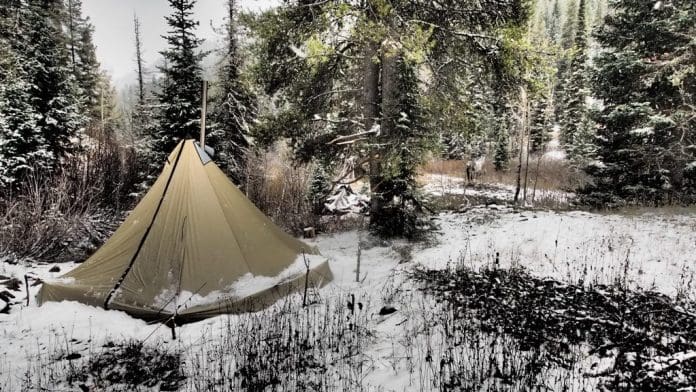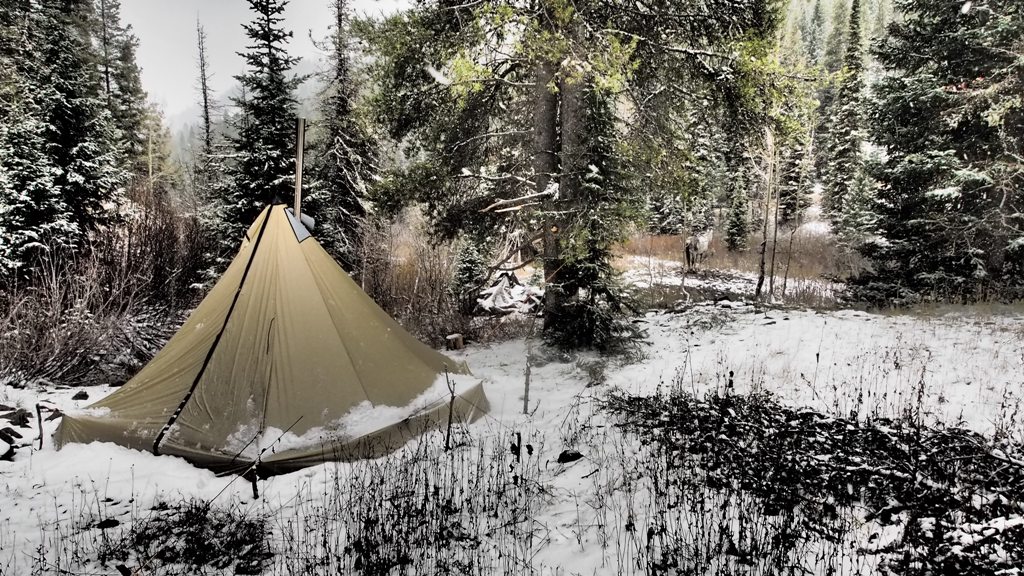
Seek Outside 8-Man Tipi/Stove Combo
By Robby Denning, Rokslide Staff
You might see me on this site and in some magazine articles hunting from some pretty big tents. That would be true. My dad taught me early on that camp is for recharging your batteries so you can hunt hard and hunt smart. If you’re only “surviving” in camp, you’re not going to hunt as effectively as you could.
One of the primary ways I access the backcoutry is by saddlehorse and packhorse. This gives me some added flexibility in tent choices and I don’t have to count grams like someone hunting soley from his back. However, I still have a refined and time-tested gear list filled with lightweight low-bulk options.
I’ve learned that for cold weather, a solo hunter needs around a 4-6 man tent while two guys better have an 8-man if they’re going to be there for more than four days and the average temp hovers around freezing with snow in the forecast. The tent must have a woodburning stove.
For over 20 years, I used Extreme Cold Military Insulated Tents in an 8-man size. Over that time, I wore out two of those tents, spending over 600 days them. Both were over 50 years old when my veteran uncles donated them to me. Like most military equipment, they worked well but were heavy, at over 30 pounds.
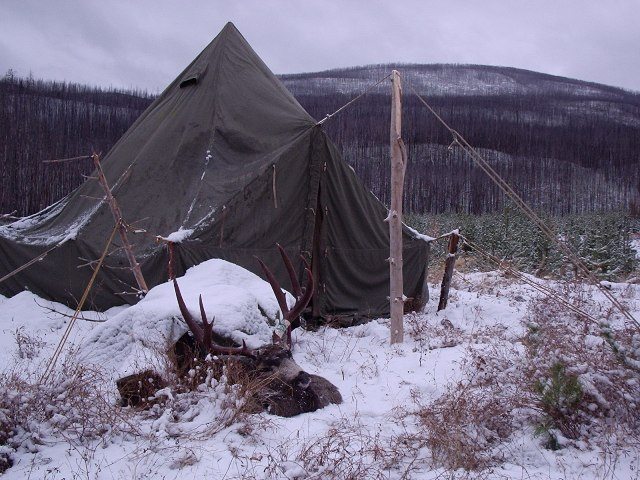
My woodburner was a stainless steel collapsable, but was heavy and bulky. This meant I needed two packhorses to get the entire set-up and the rest of my gear into the backcountry. One guy taking care of two packhorses plus a saddlehorse in the backcountry is a little much. I had been looking for ways to cut to just one packhorse.
I’d seen the lightweight tipis offered by various companies on the market and was intrigued. I was able to arrange a trade with Seek Outside of Ridgeway, Colorado. Angie and Kevin Timm started the business in 2009 and have quite a following amongst the hardcore backcountry crowd. I was thrilled to test their tipi and stove system for the 2014 season.
Although 90% of my hunting occurs alone, I do cherish the times when I’m able to go with an evenly matched hunting buddy, so I ordered my tipi in an 8-Man size (in 70 Denier nylon with silicone coating) and the XL Titanium Stove.
The setup landed on my doorstep in early September just a few days before a nine-day Colorado muzzleloader hunt I had planned. Although I was hunting from a road camp, I took the system along so I could test it before my November buck hunt far into Idaho’s backcountry where there is no margin for error when I comes to untested gear.
Colorado Dry Run
I arrived in my Western Colorado campsite late morning on the day before the opener. I literally had not had the system out of the box since receiving it, so this was all new to me. Almost on cue, a dry thunderstorm kicked up the winds to about 20-30 mph. I staked out four “corners” (the tent is a true circle design) and stood it up. It was very difficult in the wind to get the rest of the stakes set for proper tent shape. I zipped the door shut which helped, then secured the rest of the stakes as the wind died down. Although not perfect, the tent skirt traced a true circle in the Colorado dirt but there were several feet of tent wall lying limp on the ground. The tent was certainly not at full height. It seemed the adjustable carbon fiber center pole was not tall enough and suited more for a 6-Man tipi.
I had cell service, so I dialed Kevin. He had me count the pole sections and we confirmed that one was missing! He swore that all the pole sections went out with the order so I scoured the area and found the missing section behind a camp box as Kevin laughed on the phone. I inserted the pole and stood the tent to it’s full 8′ 6″ height. She looked like a palace! If I hadn’t lost the pole section nor had the wind, I think my first set up would have been under 10 minutes.
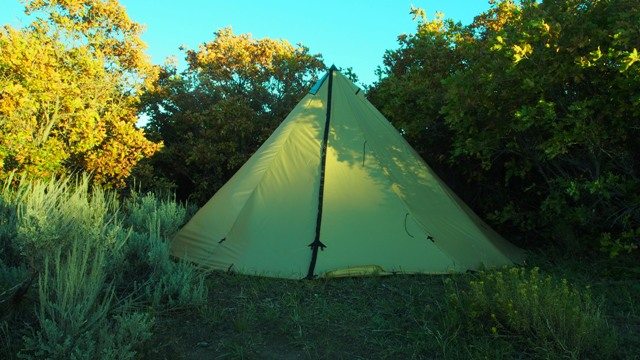
I found there were extra tie-outs located a few feet up the walls of the tent. I used them to pull the walls closer to vertical which opened up some more room in the tent. Kevin said the tie-outs are part of their “flexi-pitch” feature and can be used as stake loops lowering the tent to about the size of a 6-Man. This allows the user to set it up in smaller areas and makes the shelter less prone to wind effect if in a very windy area. The weather promised 70-80 degrees for the week so I didn’t set the stove up. By the time the sun was setting, I had camp complete and was as happy as a bug in a rug and just as snug.
Big buck sightings were few and I ended up hunting the entire nine days of the muzzleloader season. The weather stayed very warm and little rain fell, so my testing was limited to ventilation, wind performance, and condensation.
Ventilation
As about half my hunts occur in warm temperatures, ventilation is a key feature I look for. Buck hunting is slow mid-day in the early season and I’m often back at camp for a few hours. Being able to cool a tent is a real plus and the dual screen doors really helped keep the air flowing in while keeping the flying bugs out.
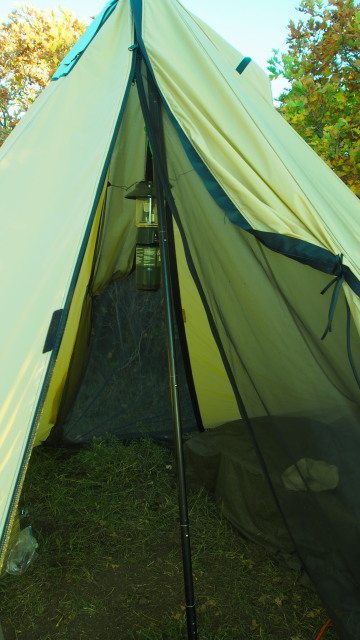
The dual screen doors allow for ample ventilation through the Tipi
Wind Performance
During the week, several more dry thunderstorms kicked up the winds to 30 mph. Several of the lightweight aluminum stakes pulled out leaving a portion of the tent flapping in the wind. The stakes are only 7.5″ long and probably fine for most conditions. I solved the problem by cutting (4) foot-long stakes from the surrounding oakbrush. The tie-out Cordura loops are extra large and easily accomodated the larger stakes. Once I did this, I never had another problem. The tent flexes in the wind as it should.
Condensation
I did notice significant condensation on the tent walls when I’d get up in the morning. With no liner to create dead air space between the tent wall and the near freezing night-time temps, this was a problem of physics, not the tent. I will be adding a liner for 2015 to solve this problem.
On the last day of the hunt, I arose around 4:00 AM with a plan to pack camp in the truck but still be on the road well before first light so I could hunt some deer country on the way out of the unit. This would save me an evening trip back to camp to get my gear. The 8-Man Tipi was an absolute cinch to put away. I think it took less than five minutes to drop it and put it back in the roomy storage bag. I never even unpacked the stove, so still had no clue how long set up/tear down would take.
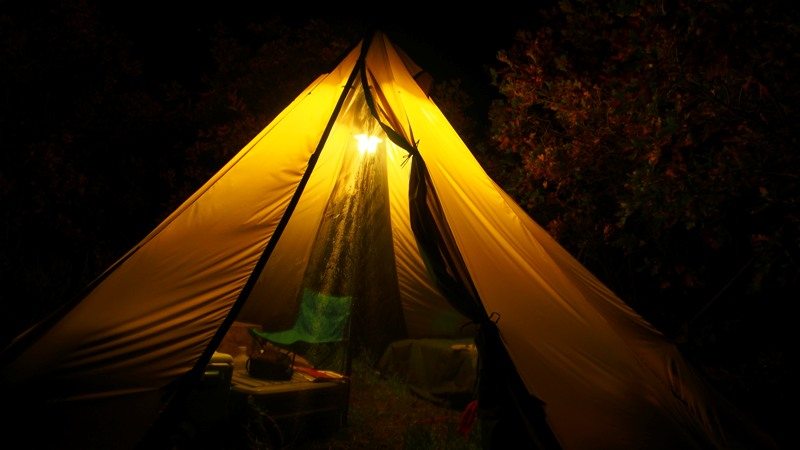
I was in the deer country by daylight pussy-footing along a rim where I’d seen good buck tracks a few days before. I was reminded that a guy should never give up on a tough hunt as I ended up killing a 180″ gross buck on the last morning of the hunt. By the time I had him quartered and backpacked to the truck, the sun was low in the western sky. I was ever so glad I didn’t have to return to camp.
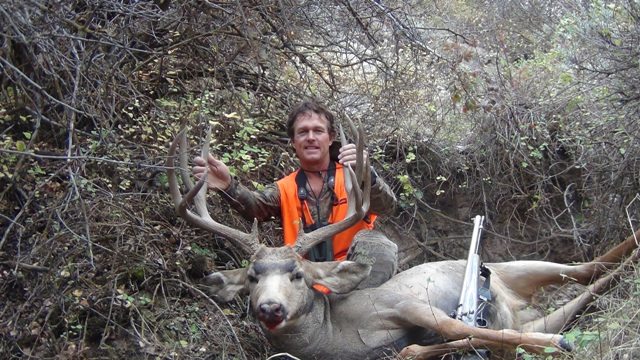
Idaho—The Full Monty
November was upon me before I knew it. I arrived at my Idaho camp five miles from the truck by horseback early afternoon on the day before I could hunt. The weather was in the 50’s but a snowstorm and cold temps were forecast for the next day. I unpacked the horses and set them to graze on a picket stake. I had the tent up in less than 10 minutes and started on the stove.
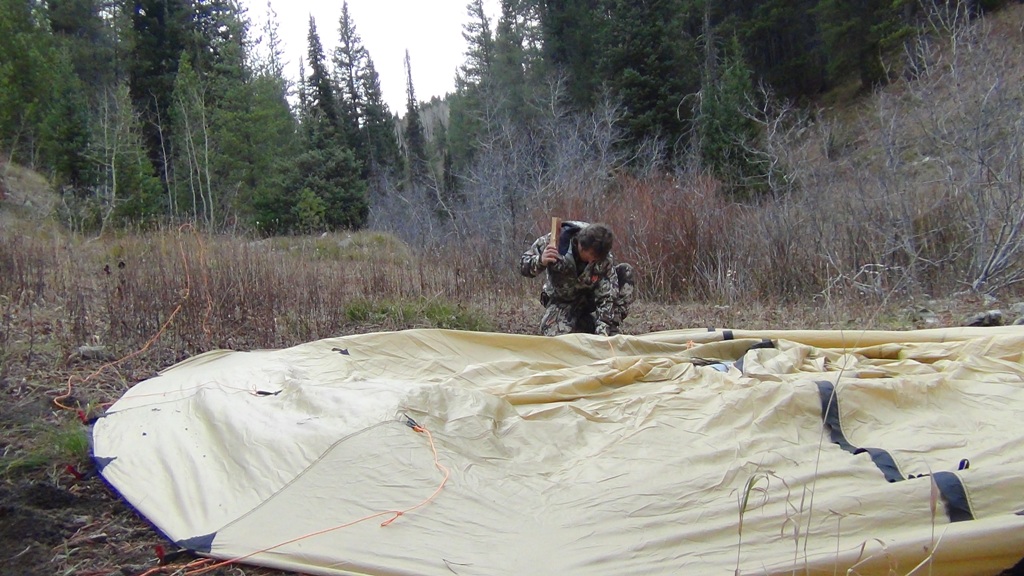
Besides a quick video I’d watched at home and a quasi assembly on my kitchen counter to confirm all the parts were there, this was my virgin set-up (I know, nothing like being totally prepared.) I had the stove up in less than 30 minutes but was reminded about the warning in the video to wear gloves by the deep cut on my finger. The Titanium is thin and sharp! I think I could set the stove up in half that time now.
The storm arrived as promised and put down three inches of heavy wet snow and dropped temps into the teens at night. She shed the snow just fine and leakage was not a problem. Like in Colorado, there was much condensation in the mornings so I had to be careful not to brush up against the sides until the fire dried them out.
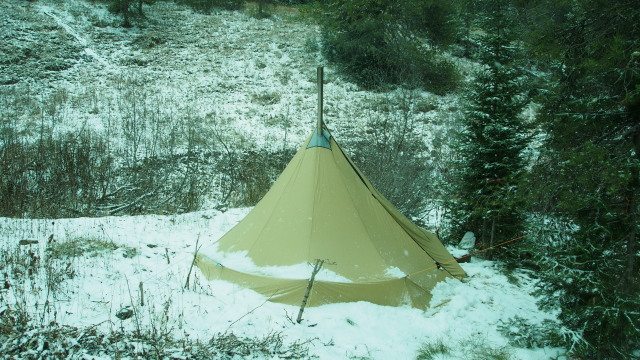
The stove drafted fairly well but I did get some backdraft in the top two holes (back home, I made Kevin laugh again when he found out I’d put the front panel on with draft holes to the side of the door. I was off 90 degrees! With the draft holes under the door and the door operation set to left-right, I’m sure this will only improve the operation of the stove.)
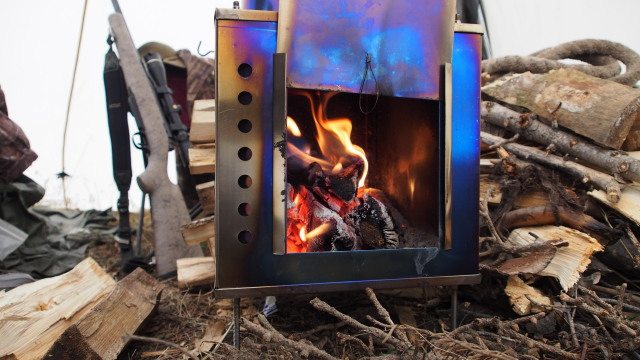
By day eight, I killed a pretty good buck for the area and had him back to camp before dark of the last eve. I was up early the next morning packing camp and loading the buck on the horses. I was very pleased to see that despite the thin Titanium, there was virtually no warpage in the stove. I’d ran the stove about six of the nine days and burned the fires as hot as I could. I was also happy to see that the built in spark arrestor had done it’s job and there were no burn holes in the tent.
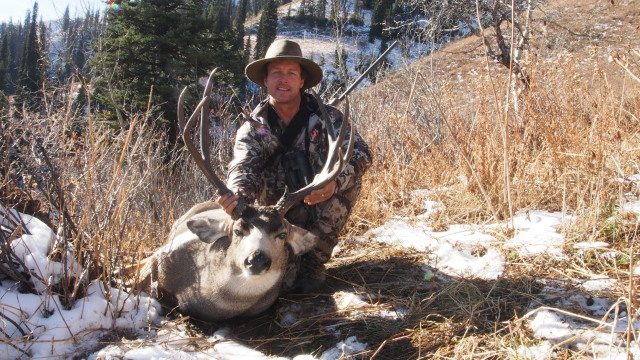
In summary, I’m very happy with the Seek Oustide 8-Man Tipi and XL Titanium Stove system. Once I add a liner to reduce condensation, it will be the near pefect set-up. Weight wise, the entire system comes in under 15 pounds (10.5 lbs tent/ 3.6 lbs stove). You could save a full 4 lbs if you opted for the 30 Denier instead of the 70 that I chose and cancelled the screen doors. With this new system, I only need one packhorse for up to a 10-day hunt.
In all, I spent 18 days in the system. Inspecting for wear, I estimate this set-up would last at least 200 days in the backcountry. Using my time-tested cost/day formula, if I exceed 200 days, (I bet I will) at a retail cost of $1,400, I’ll have spent less than $7.00 per use-day to enjoy a lightweight high-functioning shelter/stove system. To me, that is a bargain.
If you you’d like to see a video I shot in Colorado on the tent click here (I wrongly mention a weight of 25 pounds in the video- it’s actually less than 15.)
Discuss this article and enter to win Seek Outside’s new Cimmaron Tent by clicking here














